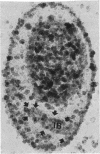Abstract
Inclusion bodies (IB) synthesized during sporulation and enterotoxin formation by Clostridium perfringens NCTC 8239 and 8798 were isolated and characterized. IB were isolated by disruption of sporangia by sonication in the presence of tetrasodium EDTA and phenylmethylsulfonyl fluoride. Fractionation was carried out in a linear gradient of sodium bromide, sucrose, or diatrizoate sodium. Denaturing and reducing agents were necessary to solubilize the IB. An alkylating agent was required to prevent reaggregation of the subunits. Molecular weight, compositional, and serological analyses and peptide mapping revealed strong similarities between the IB subunits and the enterotoxin synthesized during sporulation by C. perfringens. IB appear to represent the structural component where overproduced enterotoxin accumulates intracellularly. Enterotoxin-like subunits in the IB appeared to be held together by noncovalent and disulfide bonds, which were generally resistant to the action of intracellular proteases of C. perfringens, trypsin, or trypsin plus bile salts.
Full text
PDF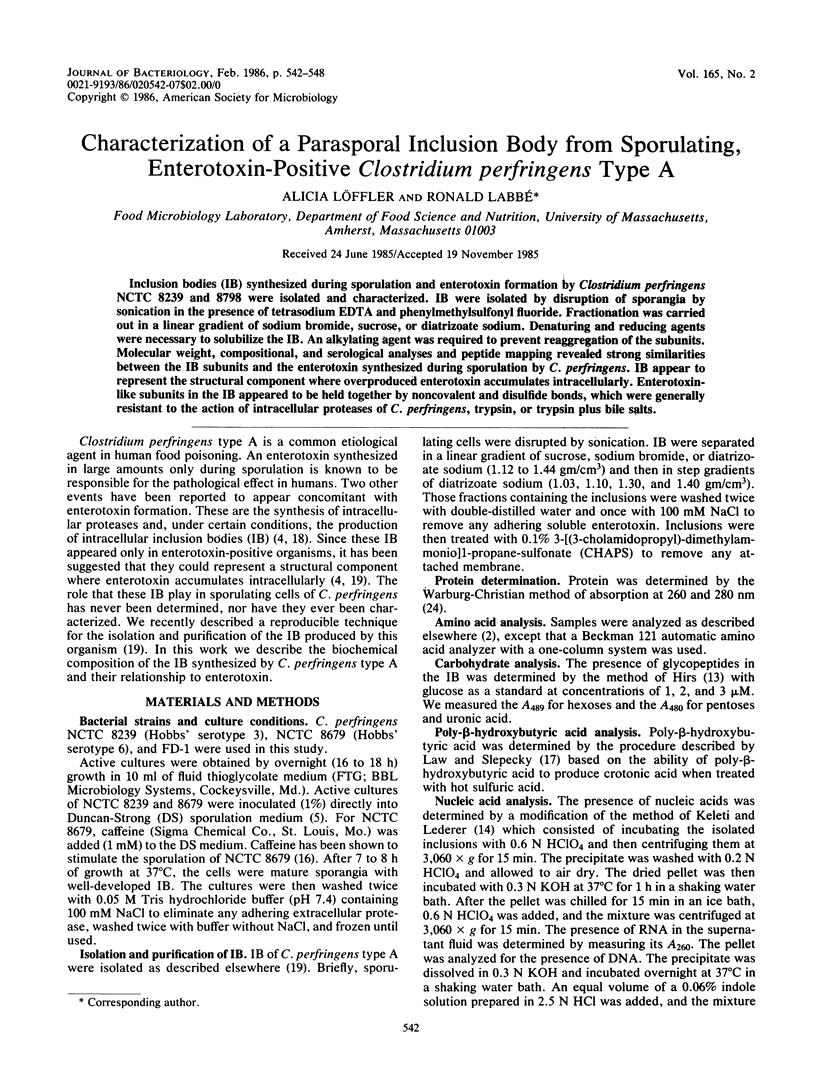
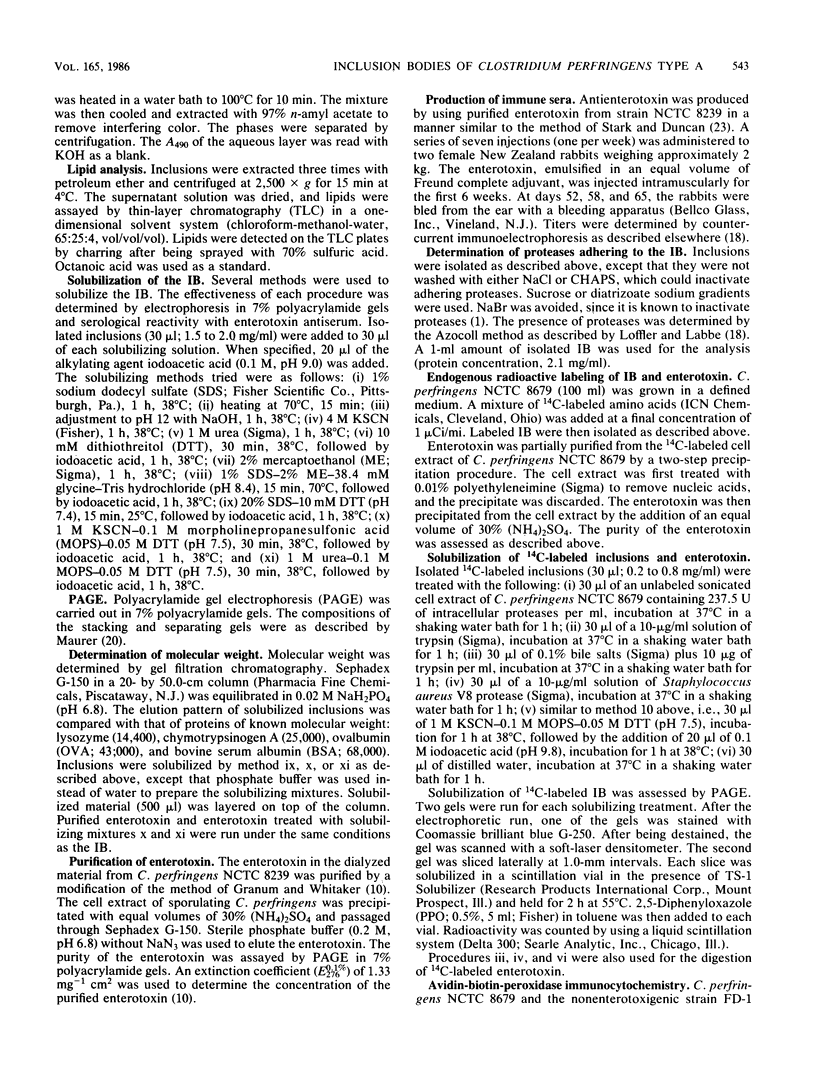
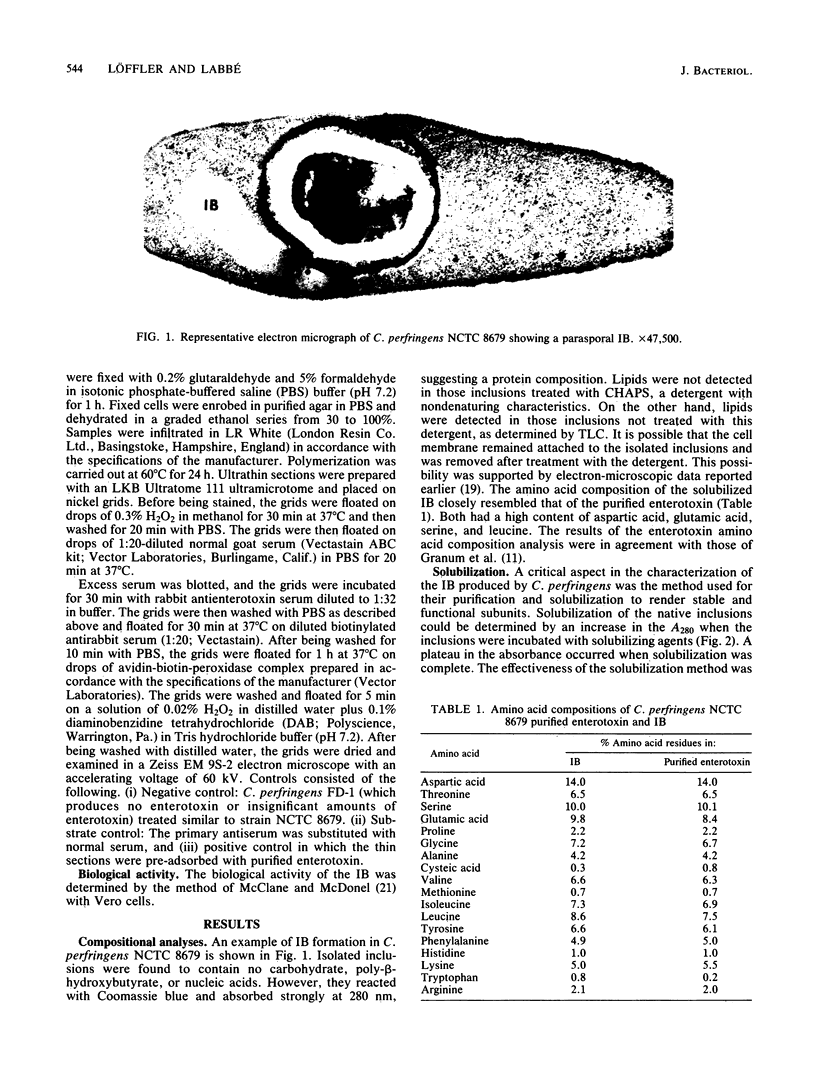
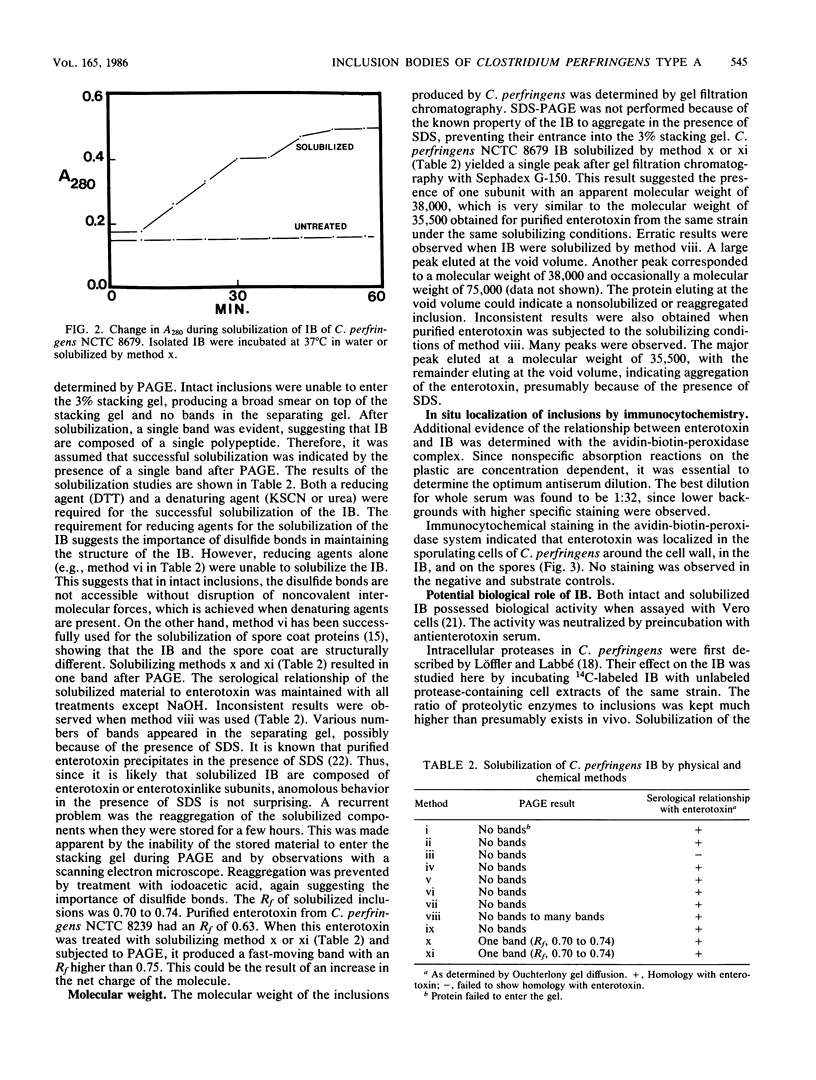
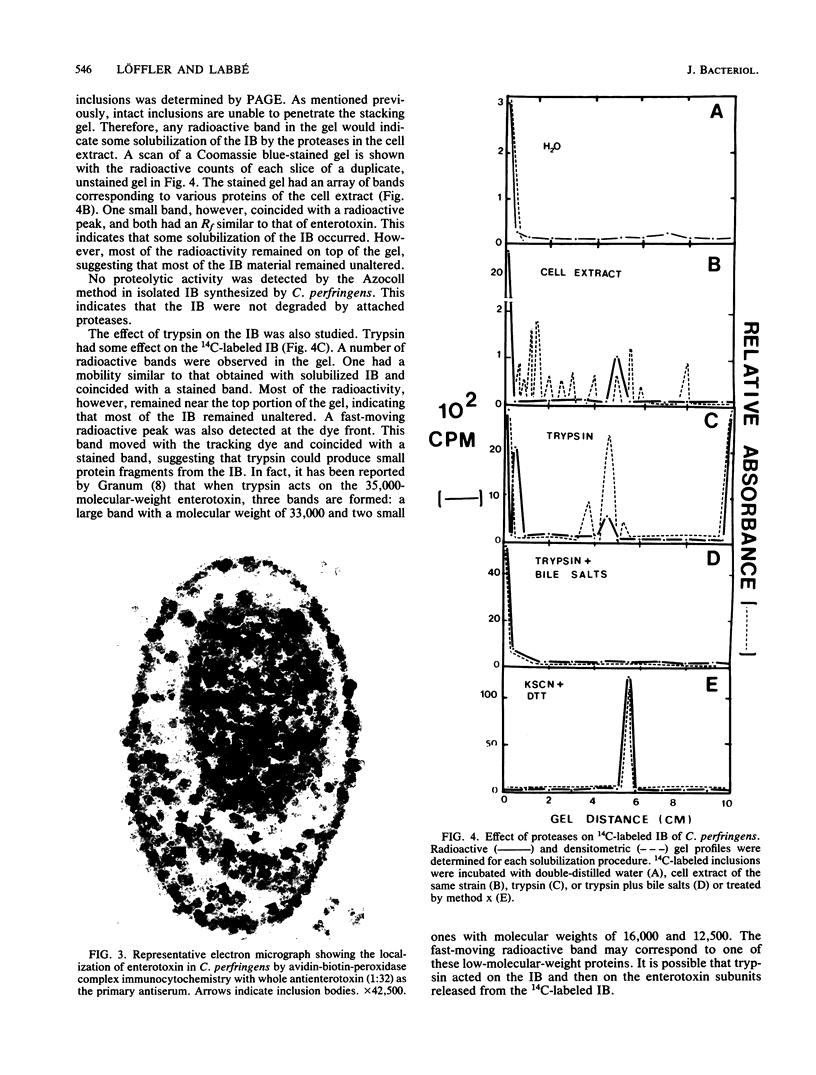
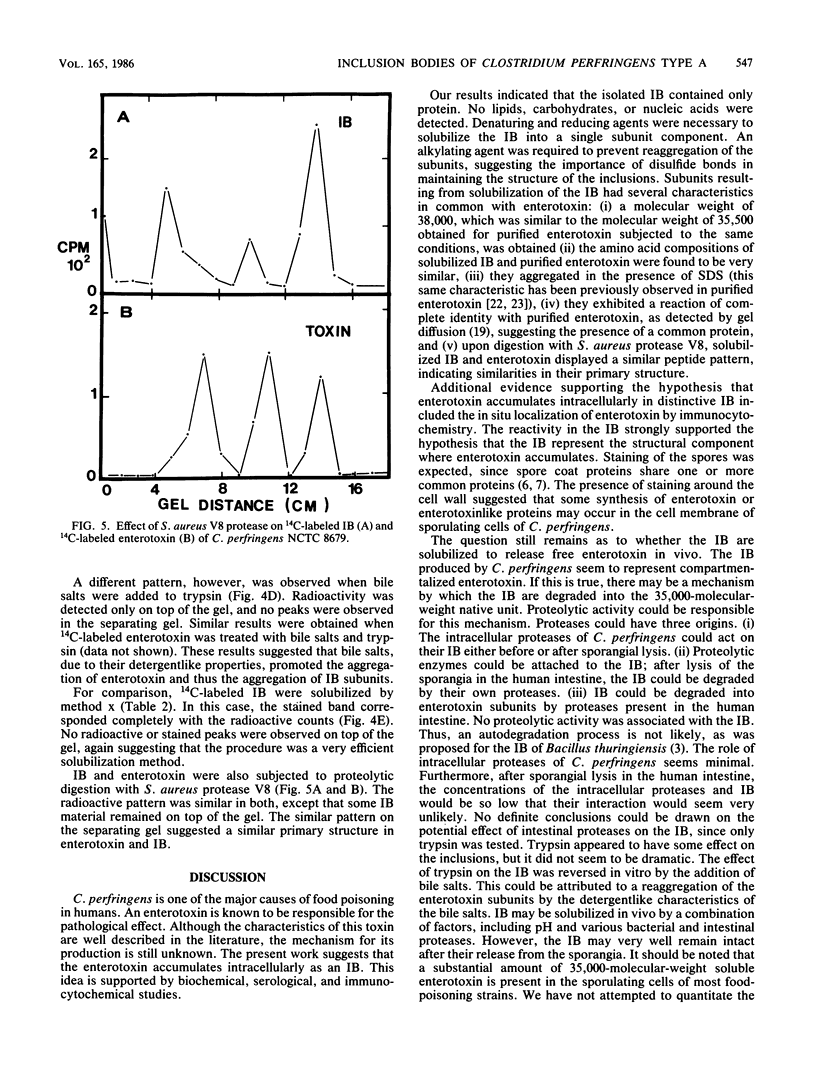
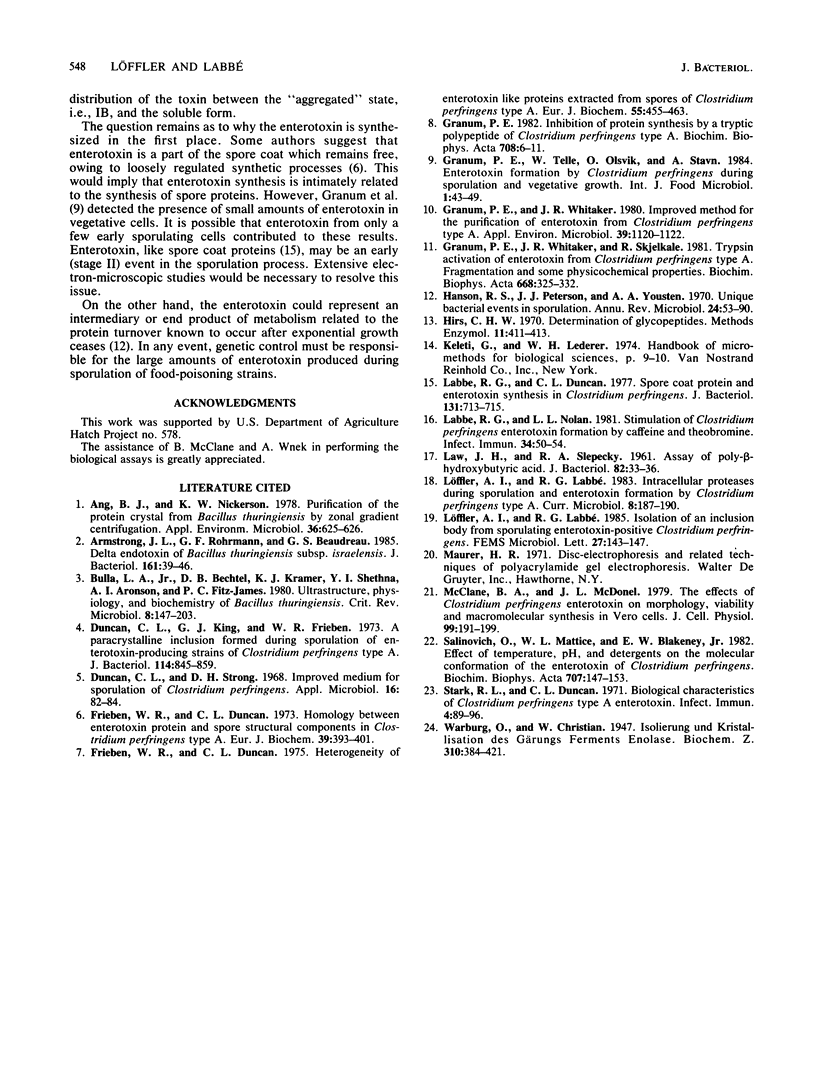
Images in this article
Selected References
These references are in PubMed. This may not be the complete list of references from this article.
- Ang B. J., Nickerson K. W. Purification of the protein crystal from Bacillus thuringiensis by zonal gradient centrifugation. Appl Environ Microbiol. 1978 Oct;36(4):625–626. doi: 10.1128/aem.36.4.625-626.1978. [DOI] [PMC free article] [PubMed] [Google Scholar]
- Armstrong J. L., Rohrmann G. F., Beaudreau G. S. Delta endotoxin of Bacillus thuringiensis subsp. israelensis. J Bacteriol. 1985 Jan;161(1):39–46. doi: 10.1128/jb.161.1.39-46.1985. [DOI] [PMC free article] [PubMed] [Google Scholar]
- Bulla L. A., Jr, Bechtel D. B., Kramer K. J., Shethna Y. I., Aronson A. I., Fitz-James P. C. Ultrastructure, physiology, and biochemistry of Bacillus thuringiensis. Crit Rev Microbiol. 1980;8(2):147–204. doi: 10.3109/10408418009081124. [DOI] [PubMed] [Google Scholar]
- Duncan C. L., King G. J., Frieben W. R. A paracrystalline inclusion formed during sporulation of enterotoxin-producing strains of Clostridium perfringens type A. J Bacteriol. 1973 May;114(2):845–859. doi: 10.1128/jb.114.2.845-859.1973. [DOI] [PMC free article] [PubMed] [Google Scholar]
- Duncan C. L., Strong D. H. Improved medium for sporulation of Clostridium perfringens. Appl Microbiol. 1968 Jan;16(1):82–89. doi: 10.1128/am.16.1.82-89.1968. [DOI] [PMC free article] [PubMed] [Google Scholar]
- Frieben W. R., Duncan C. L. Heterogeneity of enterotoxin-like protein extracted from spores fo Clostridium perfringens type A. Eur J Biochem. 1975 Jul 1;55(2):455–463. doi: 10.1111/j.1432-1033.1975.tb02182.x. [DOI] [PubMed] [Google Scholar]
- Frieben W. R., Duncan C. L. Homology between enterotoxin protein and spore structural protein in Clostridium perfringens type A. Eur J Biochem. 1973 Nov 15;39(2):393–401. doi: 10.1111/j.1432-1033.1973.tb03137.x. [DOI] [PubMed] [Google Scholar]
- Granum P. E. Inhibition of protein synthesis by a tryptic polypeptide of Clostridium perfringens type A enterotoxin. Biochim Biophys Acta. 1982 Oct 20;708(1):6–11. doi: 10.1016/0167-4838(82)90196-0. [DOI] [PubMed] [Google Scholar]
- Granum P. E., Whitaker J. R. Improved method for purification of enterotoxin from Clostridium perfringens type A. Appl Environ Microbiol. 1980 Jun;39(6):1120–1122. doi: 10.1128/aem.39.6.1120-1122.1980. [DOI] [PMC free article] [PubMed] [Google Scholar]
- Granum P. E., Whitaker J. R., Skjelkvåle R. Trypsin activation of enterotoxin from Clostridium perfringens type A: fragmentation and some physicochemical properties. Biochim Biophys Acta. 1981 May 29;668(3):325–332. doi: 10.1016/0005-2795(81)90165-3. [DOI] [PubMed] [Google Scholar]
- Hanson R. S., Peterson J. A., Yousten A. A. Unique biochemical events in bacterial sporulation. Annu Rev Microbiol. 1970;24:53–90. doi: 10.1146/annurev.mi.24.100170.000413. [DOI] [PubMed] [Google Scholar]
- LAW J. H., SLEPECKY R. A. Assay of poly-beta-hydroxybutyric acid. J Bacteriol. 1961 Jul;82:33–36. doi: 10.1128/jb.82.1.33-36.1961. [DOI] [PMC free article] [PubMed] [Google Scholar]
- Labbe R. G., Duncan C. L. Spore coat protein and enterotoxin synthesis in Clostridium perfringens. J Bacteriol. 1977 Aug;131(2):713–715. doi: 10.1128/jb.131.2.713-715.1977. [DOI] [PMC free article] [PubMed] [Google Scholar]
- Labbe R. G., Nolan L. L. Stimulation of Clostridium perfringens enterotoxin formation by caffeine and theobromine. Infect Immun. 1981 Oct;34(1):50–54. doi: 10.1128/iai.34.1.50-54.1981. [DOI] [PMC free article] [PubMed] [Google Scholar]
- McClane B. A., McDonel J. L. The effects of Clostridium perfringens enterotoxin on morphology, viability, and macromolecular synthesis in Vero cells. J Cell Physiol. 1979 May;99(2):191–200. doi: 10.1002/jcp.1040990205. [DOI] [PubMed] [Google Scholar]
- Salinovich O., Mattice W. L., Blakeney E. W., Jr Effects of temperature, pH and detergents on the molecular conformation of the enterotoxin of Clostridium perfringens. Biochim Biophys Acta. 1982 Sep 22;707(1):147–153. doi: 10.1016/0167-4838(82)90408-3. [DOI] [PubMed] [Google Scholar]
- Stark R. L., Duncan C. L. Biological characteristics of Clostridium perfringens type A enterotoxin. Infect Immun. 1971 Aug;4(2):89–96. doi: 10.1128/iai.4.2.89-96.1971. [DOI] [PMC free article] [PubMed] [Google Scholar]




